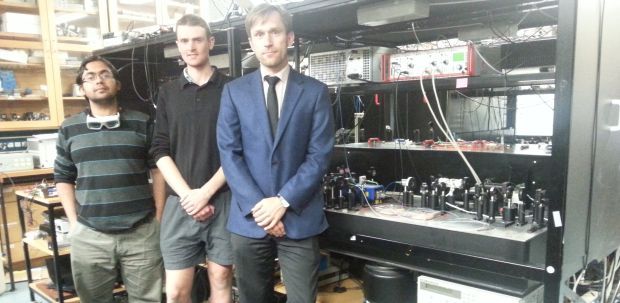The Large Hadron Collider at CERN is one of the world’s most expensive and most complex experimental facilities to date. It is a particle accelerator which lies in a 27 kilometre circular tunnel built under the ground on the Franco-Swiss border.
Here in New Zealand, at the University of Otago, a team of physicists led by Niels Kjaergaard, have created what they call the Littlest Hadron Collider.
“So where at CERN particles are travelling essentially at the speed of light, here we are colliding particles at pedestrian speeds. So that would be a metre per second,” says Niels.
 To slow down the rubidium atoms used in the laboratory, a large table is set up with a complex array of optical devices enabling the atoms to be cooled to temperatures of less than a millionth of a degree above absolute zero.
To slow down the rubidium atoms used in the laboratory, a large table is set up with a complex array of optical devices enabling the atoms to be cooled to temperatures of less than a millionth of a degree above absolute zero.
“We have two stages of magnetic trapping…and then I can take these very, very cold atoms and then I can load them into the focus of a very strong laser beam,” says Neils.
This is a process called optical tweezers, which uses two laser beams, one horizontal and the other vertical. The cloud of atoms sit where these laser beams cross and the atoms can be steered and manipulated using the tweezers.
“By taking the vertical and then dividing that into two laser beams which we move progressively from each other, we can then split this atomic cloud into two,” Niels tells Ruth Beran.

Laser optics on a table with Amita Deb, Thomas McKellar and Niels Kjaergaard (image: R. Beran)
By splitting these daughter clouds sequentially, a total of 32 equally sized clouds can be created in the Littlest Hadron Collider.
“What I naively expected was all the atoms would go into one of the tweezers but we are actually able to split them apart and then we can progressively move them further from each other,” says Niels.
While potential applications for this work include sensors that can map minute variations in magnetic fields, and new tools for probing microscropic structures, it is the fundamental science that Niels is particularly interested in.
For example, two clouds of atoms can also be smashed together to study the scattering and how they interact with each other.
“We can learn about how these atoms interact at an atomic level,” says Niels.

